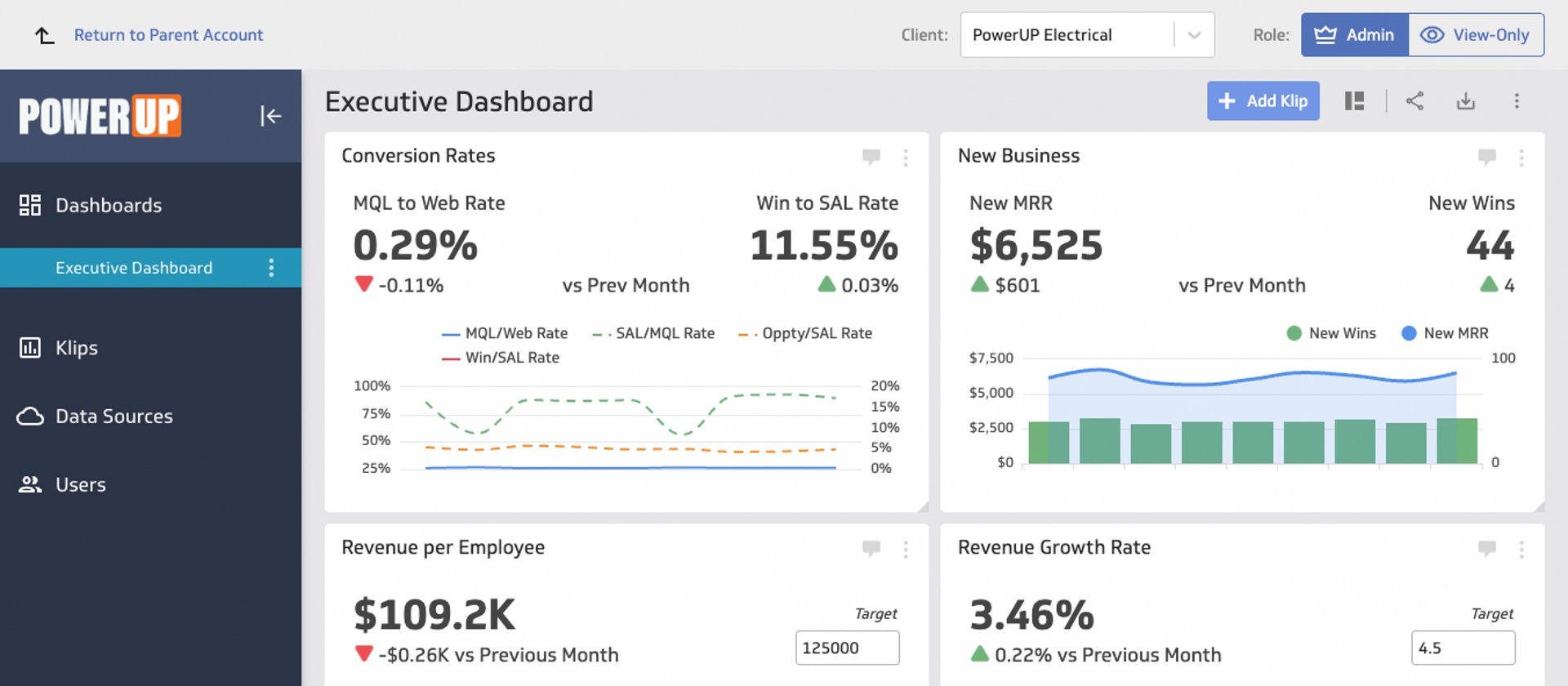Drive results with dashboards: your clients’ success is your agency’s success

Published 2023-03-21
Summary - As an agency, monitoring the success of your clients is the bread and butter of your business; you create remarkable campaigns to ultimately drive results. What if we told you that you could give your clients direct access to these metrics so they could analyze the success of your hard work in real time? One of the best and most effective ways we’ve found that agencies can do
Trust us.
We understand the effort it takes to generate, prepare, and present client reports, especially as an agency who has to repeat this process for countless clients.
Monitoring performance and reporting on it can eat up a ton of your valuable time.
Don’t you wish you could cut down on reporting time?
Truth is, you can.
Actually, we had the same wish, which is why we started Klipfolio in the first place - giving you back your time to focus on the work you do best.
As an agency, monitoring the success of your clients is the bread and butter of your business; you create remarkable campaigns to ultimately drive results. What if we told you that you could give your clients direct access to these metrics so they could analyze the success of your hard work in real time?
One of the best and most effective ways we’ve found that agencies can do this, is by using dashboard software with their clients and teaching them how to use them.
Why dashboards enhance client service and experience
- Client autonomy
In a client-agency relationship, it is no surprise that marketing ownership falls on the agency, with the agency executing the majority of the work. This goes for monitoring the success of campaigns as well. I think it’s safe to say that you are used to executing strategies and reporting on how well they actually work...right?
By using dashboards to track your clients’ success, you are ultimately passing the torch to them. Dashboards give your clients autonomy and ownership over the results of the work they are getting you to execute, whenever they want, without you having to be the middle-man.
- Greater trust and collaboration
Dashboards introduce an element of transparency to client-agency relationships, meaning an opportunity for continuous open communication. By sharing your client’s dashboards with them, you’re providing them the ability to review their analytics anytime, anywhere. By giving them full access, they may be able to catch things that you won’t see or make connections that you, as the agency, wouldn’t be able to make based on your limited knowledge of their business.
With data transparency comes greater trust and collaboration. Bottom line, there’s only so much you can be aware of since you don’t work in your clients’ offices with them.
- Communication, two ways
As an agency whose main goal is to make clients successful, you know that you produce killer work that drives results. But do your clients?
Do they really know just how great your work is?
You likely hold regular meetings with your clients to go over strategy, timelines, and progress, but how much can you really cover in that 1 hour time slot? If you get through the abundance of information, awesome, but did you miss something important? If you didn’t get through it all, what did you leave out?
By providing your clients access to their custom dashboard, they will be able to monitor and review their metrics anytime, anywhere - facilitating two-way communication. This saves a ton of time in meetings; data upfront leaves more time for brainstorming and driving results, and less time reviewing.
So if dashboards are so great, why are many client dashboards created, only to be ditched along the way?
We know that despite the work you may put into creating beautiful dashboards, many of your clients will try them out but not invest time into learning how to effectively use them. Thus, you have likely experienced clients jumping ship, abandoning their dashboards altogether. This is mainly due to the fact that they don’t understand what a huge impact this method of data monitoring can have on driving revenue for their business.
It’s important to note that despite the power of a dashboard, it’s all useless if its creation takes a ton of time, to the point that that there’s no time leftover to take action on the data that’s presented.
A data dashboard, when built properly, is the most efficient way to centralize your reporting, as it allows you to track multiple data sources and analyze the performance of marketing and other business units in one place. Real-time monitoring reduces the hours of analyzing and long line of communication that previously challenged businesses.
3 essential design tips to help ensure your clients become dashboard enthusiasts
1. Simplicity is key
Stuck with complex data sets? Use menus and filters. Can't avoid showing a complicated data set in its entirety? Be kind to your clients and use drop-down menus to allow them to filter through the data they are viewing, quickly and with ease. Straightforwardness will keep you on the right track when building your dashboard, and will keep clients happy when they are viewing your “work of art”.
2. Drill down the "why"
Ask yourself why your audience needs to see the data you are presenting. Why should they care? Remind yourself of the context in which you are designing the dashboard.
If the data doesn't add purpose or meaning to your story, ask yourself why you're showing it - be selective.
Understanding your clients and their data reporting needs will ultimately help you decide which metrics to showcase and the best way to effectively create visuals so that the data resonates. After all, clients applying the data you are showing them to make quicker and smarter business decisions is exactly what makes dashboards so powerful.
3. Design for consistency and device use
Uniformity in labelling, titles, colours, display icons, and date formatting are essential in ensuring your dashboard is easy to read and understand. Additionally, streamlining these design elements can create a sense of individuality and ownership when consistent with your client’s brand.
Knowing if the dashboard will be displayed on a TV, mobile device, or tablet, will also have a large impact on the look and feel of a dashboard; keep this in mind when you are making design decisions.
Consuming client reports… doesn’t need to be time consuming
Focus on the work that you do best. By building client dashboards, you’re not only saving valuable time, but enhancing your client service experience and, in turn, improving the impression your clients have of your agency. Your clients’ success is your agency’s success - so, design simply and consistently, and never stop asking why.
Think dashboards could benefit your agency? Learn more.
Let’s be friends.
Kick-start your data-driven journey.
Request a Klipfolio Consultation
Chat with one of our team members to find out how Klipfolio can add value to your business
Find a partner
Check our our Klipfolio Partner Directory to find the perfect fit for your specific requirements
Related Articles

Klipfolio Partner How-To #1: Duplicating dashboards across client accounts
By Stef Reid — November 27th, 2025
Client management in 5 steps
By Jonathan Taylor — November 26th, 2025
Klipfolio Partner How-To #2: Company Properties can simplify client set-up
By Stef Reid — November 26th, 2025

